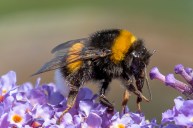While there are plenty of plants you want to avoid coming into contact with, none of them come close to the world's most dangerous plant. This plant has been referred to as the "torture" plant for its ability to inflict pain that lasts for months. Forget prickly cacti or itchy poison ivy; this most dangerous plant takes the cake.
World's Most Dangerous Plant: You Don't Want To Encounter This

Shutterstock Photo
Found in the rainforests of Australia and parts of Southeast Asia, the Dendrocnide macrolides, AKA the "Deadly Stinger, " is a plant that goes by many names, including stinging tree, stinging bush, or gympie-gympie. However, due to its long-lasting, painful side effects, the torture plant is the trending name on social media.
The world's most dangerous plant has large, heart-shaped green leaves. It also features little tooth-like structures along the edges of its leaves. While it may not look dangerous, it can inflict a great deal of pain. The State Library of Queensland shares why this is the case. They share, "Every part of the plant is covered in silica hairs which act like hypodermic needles." They continue, " If touched, they inject a venom which causes excruciating pain that can last for days, even months."
Furthermore, University of Queensland researchers and their teams recently discovered that "the plant produces a neurotoxin similar to that of a spider or cone snail." So, if you are ever hiking through the Australian wilderness, be sure not to brush up against this plant.
Brave Or Foolish?
A channel on Youtube called Brave Wilderness shared a video of a man getting up close and personal with the world's most dangerous plant. Coyote Peterson decided he wanted to see what made the deadly stinger so deadly, so he went out into the wilderness to find out.
This man willingly exposed himself to this most dangerous plant full of neurotxins. In the video he admits that it is a very unassuming plant when you look at it. However, he continues to explain that there is a lot you cannot see with the naked eye. He states, "And what you can't see with the naked eye, are these very small nettles." He also comments on the jagged edges of the leaf.
From there, Coyote does a great job at breaking down what makes this plant so deadly. He discusses the plants trichomes, or the area that holds the neurotoxic venom within the plant. He states, "When you break it down, those trichomes are little hypodermic needles. Almost like snake fangs, and the second they touch my skin and the tip breaks off, that venom is going to begin slowly working its way into my system.
From there this brave, and/or insane, man decides to rub the world's most dangerous plant on his arm to gauge his reaction to it. Almost immediately upon impact you can see his discomfort. He grunts, "Holy cow, that is very bad very quick."
The Aftermath
Very shortly after rubbing the most dangerous plant on his ar, Coyote's arm begins to turn red. He described the feeling as "On fire and being electrocuted at the same point." At a minute and a half in he admits that the pain and symptoms are steadily getting worse. He admits that if it continues to get worse over the next 20 to 30 minutes that he "might have overdone it."
Tons of bumps begin to pepper across his skin. Coyote continues to describe the horrendous sensation. "It feels like it is crawling into my skin." Not only was the area where he rubbed the leaf affected, but his entire left side. Coyote claimed he could feel discomoft in his arm, shoulder, chest and lymphnodes along his left side. Even 24 hours after coming into contact with this plant, and after local remedies, he was still feeling electrical shock impulses.
While the horrors this plant inflicts may make people want to eradicate it, you may want to hold off on that. Researchers are revealing that the sting of this plant can provide a great deal of insight into how pain works in general. Additionally, it is the hope that certain compounds of the plant can be used to create new painkillers or anasethetics.




